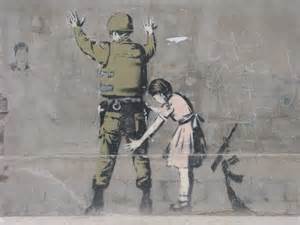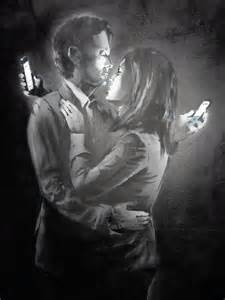Banksy: Art’s Mr. X
One of the art world’s most famous and elusive figures- Banksy, the graffiti artist whose identity is unknown to the general public, whose work is found on any wall any given morning. Read the article and answer the questions at the end.
Remember:
- You can listen to the text by pressing the ‘PLAY’ button at the end.
- Check the meaning or pronunciation by double-clicking any individual word .
- Use the Google translator at the top of the page to translate the whole text.
After a period of uncharacteristic inactivity, the street artist Banksy has returned to his familiar place: the media spotlight. Last week, two pieces of artwork became the focus of much speculation and controversy, a combination in which the furtive stencilist seems to specialise.
In Cheltenham, home of the intelligence service’s listening post GCHQ, an image of three trenchcoated spooks holding bugging equipment appeared last Sunday circling a public telephone box. Although no one claimed responsibility for the work, one expert said he was “70% to 80%” certain that it was by Banksy. Others remained doubtful.
The following day, an image of a man and a woman embracing while staring over each other’s shoulders at their respective mobile phones was placed on Banksy’s website. There was no explanation or text, but there was a photograph showing the image affixed to an urban wall. As previous works by Banksy have sold for hundreds of thousands of pounds, the website picture was enough to trigger a nationwide search for its street location.
By Tuesday, the artwork, widely referred to as Mobile Lovers, had been prised off a wall in the artist’s hometown of Bristol. A nearby youth club had taken matters – and the image – into its own hands. Dennis Stinchcombe of the Broad Plain Boys’ Club explained that if he not removed the Banksy, someone else would have done so. As a result of his intervention, he hoped to auction the work to raise £100,000 to save the underfunded youth club.
But Bristol’s mayor, George Ferguson, cried theft. Removing Mobile Lovers, he said, was “against the spirit of Banksy and street art” and asked Stinchcombe to return the work to its original site on the wall.
Thus once more a debate about art, community, authorship, ownership and value was underway and, as usual, the man at its centre was nowhere to be seen. “I’ve learned from experience that a painting isn’t finished when you put down your brush – that’s when it starts,” Banksy once observed. “The public reaction is what supplies meaning and value. Art comes alive in the arguments you have about it.”
In one way or another, Banksy has been provoking the same arguments for two decades. As the Damien Hirst-led Young British Artists have slipped out of fashion and into middle age, their mysterious near contemporary – now thought to be about 40 – has retained an ageless, mildly subversive appeal, despite becoming an established part of the art market, holding exhibitions and featuring in auctions.
How he has managed this deft act is, perversely for an artist who is often seen as an anti-capitalist commentator, a symbolic tale of our economic times. For, like any number of internet entrepreneurs, Banksy has successfully built a lucrative global brand by giving his product away.
Traditionally, the art market has thrived on concepts such as exclusivity, limited supply, controlled sales and, of course, an identifiable and authenticated artist. Yet by offering up his work for free in a countless series of unsigned guerrilla operations up and down the country, and indeed abroad, Banksy has gone some way to creating a new model for marketing art.
True, it’s unlikely that he set out to monetise graffiti when he began wielding a spray can with Bristol’s DryBreadZ Crew in the early 1990s. But that has been the effect of his carefully orchestrated stunts and equally well-managed image. He and his onetime agent, Steve Lazarides, borrowed from the word-of-mouth warehouse party scene of the 1980s to generate a new in-crowd, a hip cognoscenti who got first dibs on buying made-to-sell Banksy originals.
Initially, he sold his work at accessible prices but apparently became frustrated by how quickly they would be resold at 10 times the money. Still, by sidestepping the conventional galleries, he has been able to maintain a public stance of uncompromising detachment while simultaneously exploiting the myth and cult he has so assiduously constructed.
Central to his appeal has been an almost blank profile. The perfect paradox of his celebrity is that it rests on anonymity. Over the years, he has allowed only small but compelling details of his life to emerge. The fractured picture temptingly laid out was of a young graffitist on the streets of Bristol who went by the name of Robin Banx or Banks (from which Banksy evolved), inspired by the French stencil artist Blek le Rat and his fellow Bristolian 3D (or Robert Del Naja), who went on to form Massive Attack.
He claimed he switched from freehand spraying to stencil work to cut down time after a near escape from the police, although he has also said that he was attracted by the revolutionary history of stencils. Whatever the reason, stencils marked the point, as his biographer Will Ellsworth-Jones has noted, that humour entered his work.
In his book Wall and Piece, Banksy wrote: “When you go to an art gallery you are simply a tourist looking at the trophy cabinet of a few millionaires.” By taking art out of the gallery and sticking it up, unannounced, in the street, he fostered the idea that he was returning art to the people, a graphic Robin Hood set against the feudal grip of Mayfair’s Cork Street. In the most literal sense, he could lay claim to street credibility, even as his works were collected for six figure sums by the likes of Christina Aguilera and Angelina Jolie.
Then there was the “message” of the art. Whether they have been children digging a hole in the Israeli West Bank barrier wall or two policemen kissing, his distinctive stencils have always been satirical inversions of the status quo. They’re clever in the way that good advertising is clever – something that jumps out at you and stops you in your tracks.
“People forget what a good stencil artist he is,” says Ellsworth-Jones, author of Banksy: The Man Behind the Wall. “It’s quite easy to be a bad stencil artist, but it takes a lot of work to get the images he gets.”
But what effect does Banksy’s art have after that? Most critics argue, not very much. Matthew Collings recognises Banksy’s impact but questions his import: “From my point of view, I don’t think what he does has any value in relation to the history of art. I see that it is taken seriously by many people, so I don’t dismiss it. It’s a phenomenon. But there is nothing serious or worth considering about it. But why shouldn’t trivia have its place?”
Yet while the art may lack lasting significance, the artist himself is intriguingly durable. Not only has his radical reputation survived commercial success, but his anonymity appears to have been unaffected by exposure. Six years ago, the Mail on Sunday identified one Robin Gunningham as the real Banksy. Born in 1973 to a contracts manager and a company director’s secretary, Gunningham was from a comfortable, middle-class background and was privately educated. As rebellion is a bourgeois birthright, no one was much surprised – but it’s more telling that no one was much interested.
Far from letting daylight in on Banksy’s nocturnal magic, the biographical revelation was almost wilfully forgotten. Both his fans and detractors appeared to prefer the hooded mystery man to the suburban manager’s son. There was no public desire to see the curtain drawn back on this wizard from the west. And subsequently, as before the exposure, those journalists who have had dealings with Banksy have continued to observe a discreet silence as regards his identity.
It’s as if his role of disruptive art maverick has come to enjoy a degree of collective protection. Where once councils ordered his works to be painted over, they are now preserving them or, as in the case of the Bristol mayor, requesting that they be returned to their original street sites.
In an era when art has increasingly become a vacuous wealth statement or part of an investment portfolio, Banksy continues to be seen by many as a pomposity-pricking man of the people. Ellsworth-Jones cites the New York adventure last year where the artist offered original but unattributed Banksys in Central Park for . He sold only 0 worth, though their market value was perhaps around ,000: “It was a wonderful comment on how art is marketed.”
This may be true, but for all his social commentary and mocking cleverness, the final irony is that Banksy is still very much a successful part of that market.
guardian.co.uk © Guardian News & Media Limited 2010
Published via the Guardian News Feed plugin for WordPress.
Press ‘Start’ and complete the 10 questions below. They are questions on words or expressions in the text. Do not choose the dictionary definition, rather how it matches with its meaning in the text- Good luck!











Leave a Reply